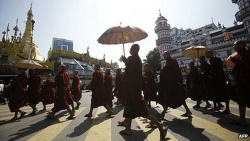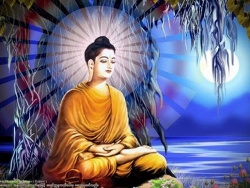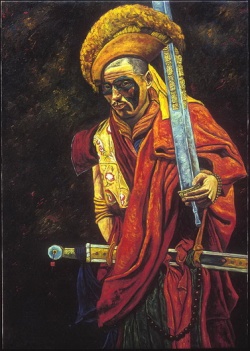Difference between revisions of "Nikko"
(Created page with " <poem> Nikko; 日興 (1246–1333) Nichiren's designated successor, also known as Hoki-ko or Hoki-bo. The founder of Taiseki-ji temple at the foot o...") |
|||
| (One intermediate revision by the same user not shown) | |||
| Line 1: | Line 1: | ||
| − | + | {{DisplayImages|2160|597|215}} | |
<poem> | <poem> | ||
[[Nikko]]; [[日興]] (1246–1333) | [[Nikko]]; [[日興]] (1246–1333) | ||
| − | [[Nichiren's]] designated successor, also known as Hoki-ko or Hoki-bo. The founder of [[Taiseki-ji]] [[temple]] at the foot of [[Mount Fuji]] in [[Japan]]. He was born at Kajikazawa in Koma District of [[Kai]] Province. His father's [[name]] was Oi no Kitsuroku, and his mother belonged to the Yui family in {{Wiki|Fuji}}. His father [[died]] while he was a child, and his mother married into another family, so his maternal grandfather raised him. In his boyhood, he entered [[Shijuku-in]], a [[temple]] of the [[Tendai school]], in [[Suruga]] Province. There, in addition to the [[Tendai doctrine]], he studied {{Wiki|Chinese}} classics, [[Japanese]] {{Wiki|literature}}, [[poetry]], {{Wiki|calligraphy}}, and other [[subjects]]. [[Shijuku-in]] was closely affiliated with [[Jisso-ji]], another [[Tendai]] [[temple]] in nearby Iwamoto. In 1258 [[Nichiren]] visited [[Jisso-ji]] to do research in its [[sutra]] library in preparation for [[writing]] On [[Establishing the Correct Teaching for the Peace of the Land]]. | + | [[Nichiren's]] designated successor, also known as [[Hoki-ko]] or [[Hoki-bo]]. The founder of [[Taiseki-ji]] [[temple]] at the foot of [[Mount Fuji]] in [[Japan]]. He was born at Kajikazawa in Koma District of [[Kai]] Province. His father's [[name]] was [[Oi no Kitsuroku]], and his mother belonged to the Yui family in {{Wiki|Fuji}}. His father [[died]] while he was a child, and his mother married into another family, so his maternal grandfather raised him. In his boyhood, he entered [[Shijuku-in]], a [[temple]] of the [[Tendai school]], in [[Suruga]] Province. There, in addition to the [[Tendai doctrine]], he studied {{Wiki|Chinese}} classics, [[Japanese]] {{Wiki|literature}}, [[poetry]], {{Wiki|calligraphy}}, and other [[subjects]]. |
| + | |||
| + | [[Shijuku-in]] was closely affiliated with [[Jisso-ji]], another [[Tendai]] [[temple]] in nearby Iwamoto. In 1258 [[Nichiren]] visited [[Jisso-ji]] to do research in its [[sutra]] library in preparation for [[writing]] On [[Establishing the Correct Teaching for the Peace of the Land]]. [[Nikko]] had an opportunity to serve [[Nichiren]] there, and decided to become his [[disciple]]. | ||
| − | Though still quite young, from that [[time]] on, he devotedly served [[Nichiren]]. He joined [[Nichiren]] in his place of exile, Izu, in 1261, and while there converted a [[priest]] of the | + | Though still quite young, from that [[time]] on, he devotedly served [[Nichiren]]. He joined [[Nichiren]] in his place of exile, Izu, in 1261, and while there converted a [[priest]] of the [[True Word]] ([[Shingon]]) school named [[Kongo-in Gyoman]] to [[Nichiren's]] teachings. [[Gyoman]] renamed his [[temple]] [[Daijo-ji]] and made [[Nikko]] its founder. In 1271 [[Nikko]] accompanied [[Nichiren]] in his exile to [[Sado]] Island. In 1274 [[Nichiren]] was released from the exile and in [[Wikipedia: [[Kamakura, Kanagawa|Kamakura]] remonstrated with [[Hei no Saemon]], the deputy chief of the Office of {{Wiki|Military}} and Police Affairs (the chief being the {{Wiki|regent}} himself). |
| − | Because this third remonstration with the rulers went unheeded, [[Nichiren]] decided to leave [[Wikipedia:Kamakura, Kanagawa|Kamakura]]. At that [[time]] | + | Because this third remonstration with the rulers went unheeded, [[Nichiren]] decided to leave [[Wikipedia:Kamakura, Kanagawa|Kamakura]]. At that [[time]] [[Nikko]] arranged with one of his converts, [[Hakiri Sanenaga]], for [[Nichiren]] to live in the [[Minobu]] area where [[Sanenaga]] was steward. [[Nikko]] recorded the lectures [[Nichiren]] gave on the [[Lotus Sutra]] to his [[disciples]] at [[Minobu]] and compiled them as The [[Record of the Orally Transmitted Teachings]] in the first month of 1278. He also led a great [[propagation]] [[effort]] in [[Kai]], [[Suruga]], and [[Izu]], which spread to other provinces. Because of his [[propagation]] [[activities]] in the [[Suruga]] area, {{Wiki|priests}} at [[Shijuku-in]] and [[Ryusen-ji]], a [[Tendai]] [[temple]] in [[Atsuhara]], converted to [[Nichiren's]] teachings. As the number of converts increased, so did the pressure on [[Nichiren's]] followers. First, in 1278 [[Nikko]] and other {{Wiki|priests}} such as {{Wiki|Nichiji}} and [[Shoken]] were expelled from [[Shi-juku-in]]. [[Nikko]] submitted a joint petition to the {{Wiki|shogunate}}, asking for an open [[debate]] with [[Gon'yo]], the temple's secretary. |
| − | At [[Ryusen-ji]] [[temple]], the deputy [[chief priest]] [[Gyochi]] expelled the {{Wiki|priests}} Nikkohad converted, including [[Nisshu]], [[Nichiben]], and [[Nichizen]], and harassed their lay converts, most of them {{Wiki|farmers}}. Eventually, on the twenty-first day of the ninth month, 1279, twenty of these {{Wiki|farmers}} were arrested on false charges and sent to [[Wikipedia:Kamakura, Kanagawa|Kamakura]]. | + | At [[Ryusen-ji]] [[temple]], the deputy [[chief priest]] [[Gyochi]] expelled the {{Wiki|priests}} Nikkohad converted, including [[Nisshu]], [[Nichiben]], and [[Nichizen]], and harassed their lay converts, most of them {{Wiki|farmers}}. Eventually, on the twenty-first day of the ninth month, 1279, twenty of these {{Wiki|farmers}} were arrested on false charges and sent to [[Wikipedia:Kamakura, Kanagawa|Kamakura]]. [[Nikko]] immediately drafted a petition with [[Nichiren]], who wrote the first part of it, and had [[Nisshu]] and [[Nichiren]] copy and submit it jointly to the {{Wiki|shogunate}}. Three of the arrested believers were beheaded, and the others were banished from [[Atsuhara]]. This incident is known as the [[Atsuhara Persecution]]. Their courageous [[faith]] is said to have motivated [[Nichiren]] to inscribe the [[object of devotion]] for all [[humanity]] (commonly known as the [[Dai-Gohonzon]]), which he alluded to in his [[writing]] as the purpose of his [[life]]. |
In 1282 [[Nichiren]], sensing that his [[death]] was near, designated [[Nikko]] as his successor with two transfer documents, one written in the ninth month at [[Minobu]] and the other on the day of his [[death]], the thirteenth day of the tenth month at [[Wikipedia:Ikegami Honmon-ji |Ikegami]]. The latter document also stated that [[Nikko]] should be [[chief priest]] of [[Kuon-ji]] [[temple]] at [[Minobu]]. After [[Nichiren's]] [[funeral]], [[Nikko]] brought his ashes to [[Minobu]] and placed them in a tomb. On the hundredth day after [[Nichiren's]] [[death]], he held a memorial service. At that [[time]] eighteen priests—the six senior {{Wiki|priests}} and twelve of their disciples—assumed the {{Wiki|responsibility}} of attending to the tomb in rotation, one of the six senior {{Wiki|priests}} or two of his [[disciples]] watching over it each month. | In 1282 [[Nichiren]], sensing that his [[death]] was near, designated [[Nikko]] as his successor with two transfer documents, one written in the ninth month at [[Minobu]] and the other on the day of his [[death]], the thirteenth day of the tenth month at [[Wikipedia:Ikegami Honmon-ji |Ikegami]]. The latter document also stated that [[Nikko]] should be [[chief priest]] of [[Kuon-ji]] [[temple]] at [[Minobu]]. After [[Nichiren's]] [[funeral]], [[Nikko]] brought his ashes to [[Minobu]] and placed them in a tomb. On the hundredth day after [[Nichiren's]] [[death]], he held a memorial service. At that [[time]] eighteen priests—the six senior {{Wiki|priests}} and twelve of their disciples—assumed the {{Wiki|responsibility}} of attending to the tomb in rotation, one of the six senior {{Wiki|priests}} or two of his [[disciples]] watching over it each month. | ||
| − | The five senior {{Wiki|priests}} other than | + | The five senior {{Wiki|priests}} other than [[Nikko]] then left for their respective areas. None of them, however, returned to fulfill their commitment to attend to [[Nichiren's]] tomb. Under pressure from the authorities, they gradually began to disassociate themselves from [[Nichiren's]] teachings and worshiped images of [[Shakyamuni Buddha]], declaring themselves to be {{Wiki|priests}} of the [[Tendai school]]. [[Niko]], one of the six senior {{Wiki|priests}}, returned to [[Minobu]] around 1285, and [[Nikko]] appointed him the [[chief instructor]] of {{Wiki|priests}}. |
| − | Under | + | Under [[Nikko's]] influence, however, [[Hakiri Sanenaga]], the steward of the area and one of [[Nichiren's]] followers, commissioned a statue of [[Shakyamuni Buddha]], made [[pilgrimages]] to [[Shinto]] [[shrines]], contributed to the erecting of a tower of the [[Pure Land]] ( [[Jodo]]) school, and even had a [[Pure Land]] [[temple]] built. |
| − | [[Nikko]] repeatedly warned them that such acts flagrantly contradicted [[Nichiren's]] teachings, but to no avail. Convinced that [[Minobu]] would not be the place to preserve [[Nichiren's]] teachings, | + | [[Nikko]] repeatedly warned them that such acts flagrantly contradicted [[Nichiren's]] teachings, but to no avail. Convinced that [[Minobu]] would not be the place to preserve [[Nichiren's]] teachings, [[Nikko]] left in the spring of 1289, taking the [[Dai-Gohonzon]], [[Nichiren's]] ashes, and other [[treasures]] with him. He stayed for a while at the home of his maternal grandfather in Kawai of [[Wikipedia:Fuji District, Shizuoka|Fuji District]], but soon moved to Nanjo Tokimitsu's estate at the latter's invitation. |
| − | In 1290 | + | In 1290 [[Nikko]] built a [[temple]] called [[Dai-bo]] (Grand Lodging) on a tract of land donated by [[Tokimitsu]]. His [[disciples]] also established their lodging [[temples]] surrounding [[Dai-bo]]. This was the origin of [[Taiseki-ji]]. [[Nikko]] [[concentrated]] all his efforts on promoting [[Nichiren's]] teachings, educating [[disciples]], and collecting and transcribing [[Nichiren's]] writings, which he called the [[Gosho]], or [[honorable writings]]. |
| − | In 1298 [[Nikko]] established a seminary at nearby [[Omosu]], moved there, and devoted himself to training his [[disciples]]. [[Nichimoku]], Nikke, Nis-shu, [[Nichizen]], Nissen, and Nichijoare known as his six elder [[disciples]], whom he assigned to {{Wiki|protect}} the [[Dai-Gohonzon]]. At this point, [[Nichimoku]] functionally became the [[chief priest]] of [[Taiseki-ji]]. | + | In 1298 [[Nikko]] established a seminary at nearby [[Omosu]], moved there, and devoted himself to training his [[disciples]]. [[Nichimoku]], [[Nikke]], [[Nis-shu]], [[Nichizen]], [[Nissen]], and Nichijoare known as his six elder [[disciples]], whom he assigned to {{Wiki|protect}} the [[Dai-Gohonzon]]. At this point, [[Nichimoku]] functionally became the [[chief priest]] of [[Taiseki-ji]]. [[Nikko]] also designated six new [[disciples]] ([[Nichidai]], [[Nitcho]], [[Nichido]], [[Nichimyo]], [[Nichigo]], and [[Nichijo]]), whom he charged with the task of [[propagation]] after his [[death]]. |
| − | In the eleventh month of 1332, [[Nikko]] officially appointed [[Nichimoku]] as his successor and wrote Matters to Be Observed after [[Nikko's]] [[Death]]. Shortly before his [[death]], he left The Twenty-six Admonitions of [[Nikko]] as a warning to believers in general and {{Wiki|priests}} in particular to preserve and uphold [[Nichiren's]] teachings correctly. | + | In the eleventh month of 1332, [[Nikko]] officially appointed [[Nichimoku]] as his successor and wrote [[Matters to Be Observed]] after [[Nikko's]] [[Death]]. Shortly before his [[death]], he left The Twenty-six Admonitions of [[Nikko]] as a warning to believers in general and {{Wiki|priests}} in particular to preserve and uphold [[Nichiren's]] teachings correctly. |
| − | (2)[日光]( Jpn): The [[bodhisattva]] | + | (2)[日光]( Jpn): The [[bodhisattva Sunligh]]t ([[Nikko-bosatsu]]). One of the two [[bodhisattvas]] who attend [[Medicine Master Buddha]], the other being [[Gakko]] ([[Moonlight]]). |
| − | See Sunlight. | + | See; [[Sunlight]]. |
</poem> | </poem> | ||
| + | {{R}} | ||
| + | [http://www.sgilibrary.org/search_dict.php?SearchSelect=dict&p=2&m=1&in=2&q=Nikko www.sgilibrary.org] | ||
| + | [[CategoryNichiren:]] | ||
Latest revision as of 14:41, 17 April 2014
Nikko; 日興 (1246–1333)
Nichiren's designated successor, also known as Hoki-ko or Hoki-bo. The founder of Taiseki-ji temple at the foot of Mount Fuji in Japan. He was born at Kajikazawa in Koma District of Kai Province. His father's name was Oi no Kitsuroku, and his mother belonged to the Yui family in Fuji. His father died while he was a child, and his mother married into another family, so his maternal grandfather raised him. In his boyhood, he entered Shijuku-in, a temple of the Tendai school, in Suruga Province. There, in addition to the Tendai doctrine, he studied Chinese classics, Japanese literature, poetry, calligraphy, and other subjects.
Shijuku-in was closely affiliated with Jisso-ji, another Tendai temple in nearby Iwamoto. In 1258 Nichiren visited Jisso-ji to do research in its sutra library in preparation for writing On Establishing the Correct Teaching for the Peace of the Land. Nikko had an opportunity to serve Nichiren there, and decided to become his disciple.
Though still quite young, from that time on, he devotedly served Nichiren. He joined Nichiren in his place of exile, Izu, in 1261, and while there converted a priest of the True Word (Shingon) school named Kongo-in Gyoman to Nichiren's teachings. Gyoman renamed his temple Daijo-ji and made Nikko its founder. In 1271 Nikko accompanied Nichiren in his exile to Sado Island. In 1274 Nichiren was released from the exile and in [[Wikipedia: Kamakura remonstrated with Hei no Saemon, the deputy chief of the Office of Military and Police Affairs (the chief being the regent himself).
Because this third remonstration with the rulers went unheeded, Nichiren decided to leave Kamakura. At that time Nikko arranged with one of his converts, Hakiri Sanenaga, for Nichiren to live in the Minobu area where Sanenaga was steward. Nikko recorded the lectures Nichiren gave on the Lotus Sutra to his disciples at Minobu and compiled them as The Record of the Orally Transmitted Teachings in the first month of 1278. He also led a great propagation effort in Kai, Suruga, and Izu, which spread to other provinces. Because of his propagation activities in the Suruga area, priests at Shijuku-in and Ryusen-ji, a Tendai temple in Atsuhara, converted to Nichiren's teachings. As the number of converts increased, so did the pressure on Nichiren's followers. First, in 1278 Nikko and other priests such as Nichiji and Shoken were expelled from Shi-juku-in. Nikko submitted a joint petition to the shogunate, asking for an open debate with Gon'yo, the temple's secretary.
At Ryusen-ji temple, the deputy chief priest Gyochi expelled the priests Nikkohad converted, including Nisshu, Nichiben, and Nichizen, and harassed their lay converts, most of them farmers. Eventually, on the twenty-first day of the ninth month, 1279, twenty of these farmers were arrested on false charges and sent to Kamakura. Nikko immediately drafted a petition with Nichiren, who wrote the first part of it, and had Nisshu and Nichiren copy and submit it jointly to the shogunate. Three of the arrested believers were beheaded, and the others were banished from Atsuhara. This incident is known as the Atsuhara Persecution. Their courageous faith is said to have motivated Nichiren to inscribe the object of devotion for all humanity (commonly known as the Dai-Gohonzon), which he alluded to in his writing as the purpose of his life.
In 1282 Nichiren, sensing that his death was near, designated Nikko as his successor with two transfer documents, one written in the ninth month at Minobu and the other on the day of his death, the thirteenth day of the tenth month at Ikegami. The latter document also stated that Nikko should be chief priest of Kuon-ji temple at Minobu. After Nichiren's funeral, Nikko brought his ashes to Minobu and placed them in a tomb. On the hundredth day after Nichiren's death, he held a memorial service. At that time eighteen priests—the six senior priests and twelve of their disciples—assumed the responsibility of attending to the tomb in rotation, one of the six senior priests or two of his disciples watching over it each month.
The five senior priests other than Nikko then left for their respective areas. None of them, however, returned to fulfill their commitment to attend to Nichiren's tomb. Under pressure from the authorities, they gradually began to disassociate themselves from Nichiren's teachings and worshiped images of Shakyamuni Buddha, declaring themselves to be priests of the Tendai school. Niko, one of the six senior priests, returned to Minobu around 1285, and Nikko appointed him the chief instructor of priests.
Under Nikko's influence, however, Hakiri Sanenaga, the steward of the area and one of Nichiren's followers, commissioned a statue of Shakyamuni Buddha, made pilgrimages to Shinto shrines, contributed to the erecting of a tower of the Pure Land ( Jodo) school, and even had a Pure Land temple built.
Nikko repeatedly warned them that such acts flagrantly contradicted Nichiren's teachings, but to no avail. Convinced that Minobu would not be the place to preserve Nichiren's teachings, Nikko left in the spring of 1289, taking the Dai-Gohonzon, Nichiren's ashes, and other treasures with him. He stayed for a while at the home of his maternal grandfather in Kawai of Fuji District, but soon moved to Nanjo Tokimitsu's estate at the latter's invitation.
In 1290 Nikko built a temple called Dai-bo (Grand Lodging) on a tract of land donated by Tokimitsu. His disciples also established their lodging temples surrounding Dai-bo. This was the origin of Taiseki-ji. Nikko concentrated all his efforts on promoting Nichiren's teachings, educating disciples, and collecting and transcribing Nichiren's writings, which he called the Gosho, or honorable writings.
In 1298 Nikko established a seminary at nearby Omosu, moved there, and devoted himself to training his disciples. Nichimoku, Nikke, Nis-shu, Nichizen, Nissen, and Nichijoare known as his six elder disciples, whom he assigned to protect the Dai-Gohonzon. At this point, Nichimoku functionally became the chief priest of Taiseki-ji. Nikko also designated six new disciples (Nichidai, Nitcho, Nichido, Nichimyo, Nichigo, and Nichijo), whom he charged with the task of propagation after his death.
In the eleventh month of 1332, Nikko officially appointed Nichimoku as his successor and wrote Matters to Be Observed after Nikko's Death. Shortly before his death, he left The Twenty-six Admonitions of Nikko as a warning to believers in general and priests in particular to preserve and uphold Nichiren's teachings correctly.
(2)[日光]( Jpn): The bodhisattva Sunlight (Nikko-bosatsu). One of the two bodhisattvas who attend Medicine Master Buddha, the other being Gakko (Moonlight).
See; Sunlight.


